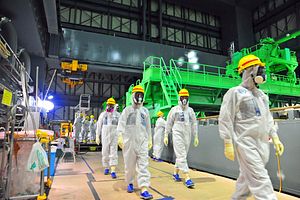News of further difficulties at the Fukushima Daiichi Nuclear Power Plant has been coming out this week, as the cleanup being led by Tokyo Electric Power Co. (TEPCO) continues to struggle with the challenge of dealing with huge volumes of contaminated water, while slowly implementing the actual removal of nuclear material. These dual problems don’t show any sign of abating in the near future however, as most of TEPCO’s efforts to stem the tide of contaminated water have not been successful.
On Wednesday, the Jiji Press reported that according to TEPCO officials, the company “appears unable to stem the flow of radioactive water from the No. 2 reactor building to underground tunnels at the Fukushima No. 1 power plant.” After a failed attempt to create an “ice wall” this summer to freeze water inside the joints connecting the tunnels, TEPCO switched to injecting cement, which is also proving ineffective. There is groundwater entering the facility from outside, as well as water being used to cool fuel near the top of the reactors, all of which becomes contaminated and must be safely stored. TEPCO is attempting to stem the large flow of groundwater entering from outside. It says if the cement injections alone do not work, it “plans to remove radioactive water while injecting cement into the tunnel.”
This problem of contaminated water is drawing the lion’s share of TEPCO’s efforts, while also contributing to the extended timeline and astronomical costs of the cleanup. The Associated Press reports that 6,000 workers now go to the stricken plant every day, which is more than two or three times as many as the number working at the plant while it was operating. Of those 6,000, fewer than 200 were devoted to work focused on the dismantling of the reactors and the removal of fuel on a recent normal work day; the rest were attempting to mitigate the water issue. This imbalance could quickly exhaust the number or workers available, as each person has an annual limit of radiation exposure.
Aside from dealing with the contaminated water, the actual nuclear cleanup process will be lengthy. There are four reactors that will need melted fuel and additional fuel rods removed, as well as radioactive debris on top of the buildings, which must be taken away and safely stored. While some fuel has been removed from reactor No. 4, the process for No. 1 and No. 2 has been delayed by five years. The process for all four reactors is expected to last around 40 years at least.
Finally, the cost of the cleanup may be the most devastating part for both TEPCO and the government. They estimate that addressing just the water issue and decontamination will cost 2 trillion yen ($17 billion), while the cost of compensating local residents and fully decommissioning the reactors will reach 10 trillion yen in total. It is figures like this that will make the government’s attempts at a general nuclear restart for the country a hard sell. Decades of work and trillions of yen are hardly reassuring when so many of Japan’s nuclear reactors sit near active fault lines, volcanoes, and tsunami-prone shores.

































